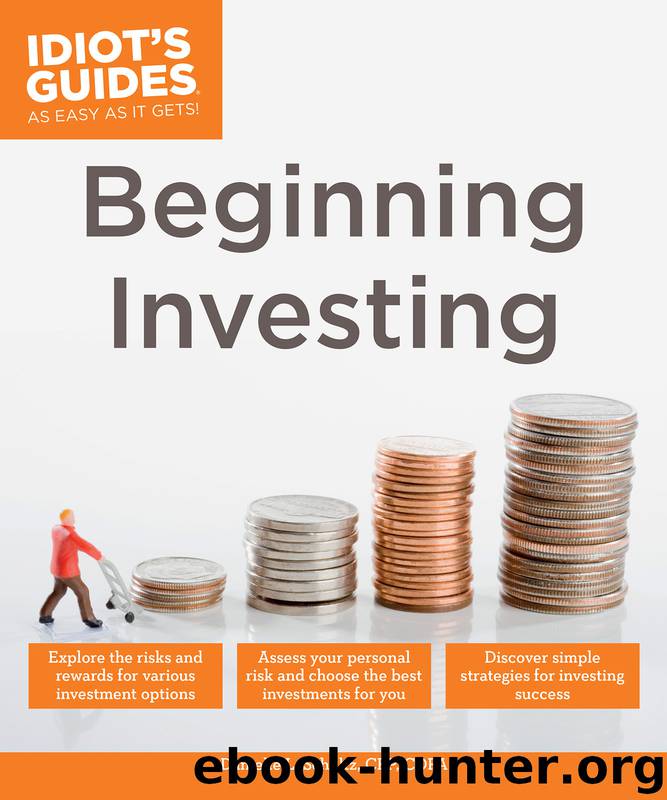Idiot's Guides - Beginning Investing by Danielle L. Schultz

Author:Danielle L. Schultz
Language: eng
Format: epub
Publisher: DK Publishing
Definition
The market for used bonds is called the secondary market.
Generally, the current value of a bond will have some correspondence to now-current rates. For example, let’s look at the way an individual bond might change. In our example, John Elder bought $15,000 worth of BBB rated 30-year bonds in 1997. They paid 7.8 percent at purchase. In 2027 he or his heirs will get their $15,000 back, and in the meantime he collects $585 twice a year ($1,170 per year total) in interest. In retrospect, given current rates, it looks like a great deal.
But let’s say John needs that money now. He can sell the bonds today for $129.679 each, or a total of $19,451.85 (approximately). He won’t collect any more interest—his buyer now gets the interest. But, given the purchase price, the interest is worth only 6 percent to the buyer, the term is shorter, and the bond is still callable. (In real life, the buyer is also going to pay a commission, and any accrued [pro-rated] interest due to the original purchaser up until the time the bond is actually sold.) The buyer is taking more risk for less reward than the original bond owner, but compared to current market returns, it may be worth the risk. This is called the current yield.
However, there’s another way to think about the worth of a bond that you’re selling or buying, called the yield to maturity. This is a combination of the current income generated by the bond, plus any change in its value when it’s held until maturity. You’ll need a financial calculator to calculate the rather complex formula, so I’m not going to go into it here (and if you’re buying, the investment house should be able to tell you). On the earlier bond, the yield to maturity is about 4.38 percent. It’s generally thought to be a more accurate estimate of the bond’s return (of course, conditions can change) and is more in line with competitive current rates for the same type of bond.
Finally, there’s the yield to call, which is the yield if the bond were to be called on the earliest possible date. Weigh all three of these to scope out your potential return, depending on your time horizon and intentions for the bond. Services like Morningstar or the brokerage you’re using for trading can supply you with all these figures based on the day-to-day trading price of the bond.
Download
This site does not store any files on its server. We only index and link to content provided by other sites. Please contact the content providers to delete copyright contents if any and email us, we'll remove relevant links or contents immediately.
Rich Dad Poor Dad by Robert T. Kiyosaki(6185)
Pioneering Portfolio Management by David F. Swensen(6083)
How To Win Friends and Influence People by Dale Carnegie(4340)
The Money Culture by Michael Lewis(3851)
The Dhandho Investor by Mohnish Pabrai(3564)
The Wisdom of Finance by Mihir Desai(3529)
Liar's Poker by Michael Lewis(3228)
The Intelligent Investor by Benjamin Graham Jason Zweig(2936)
The ONE Thing by Gary Keller(2922)
Mastering Bitcoin: Programming the Open Blockchain by Andreas M. Antonopoulos(2895)
Fooled by Randomness: The Hidden Role of Chance in Life and in the Markets by Nassim Nicholas Taleb(2866)
Rich Dad Poor Dad: What The Rich Teach Their Kids About Money - That The Poor And Middle Class Do Not! by Robert T. Kiyosaki(2836)
How to Win Friends and Influence People by Dale Carnegie(2799)
Investing For Dummies by Eric Tyson(2798)
How to Day Trade for a Living: Tools, Tactics, Money Management, Discipline and Trading Psychology by Andrew Aziz(2787)
Market Wizards by Jack D. Schwager(2545)
Zero Hour by Harry S. Dent Jr. & Andrew Pancholi(2536)
How to Pay Zero Taxes, 2018 by Jeff A. Schnepper(2503)
Rich Dad's Guide to Investing by Robert T. Kiyosaki(2412)
